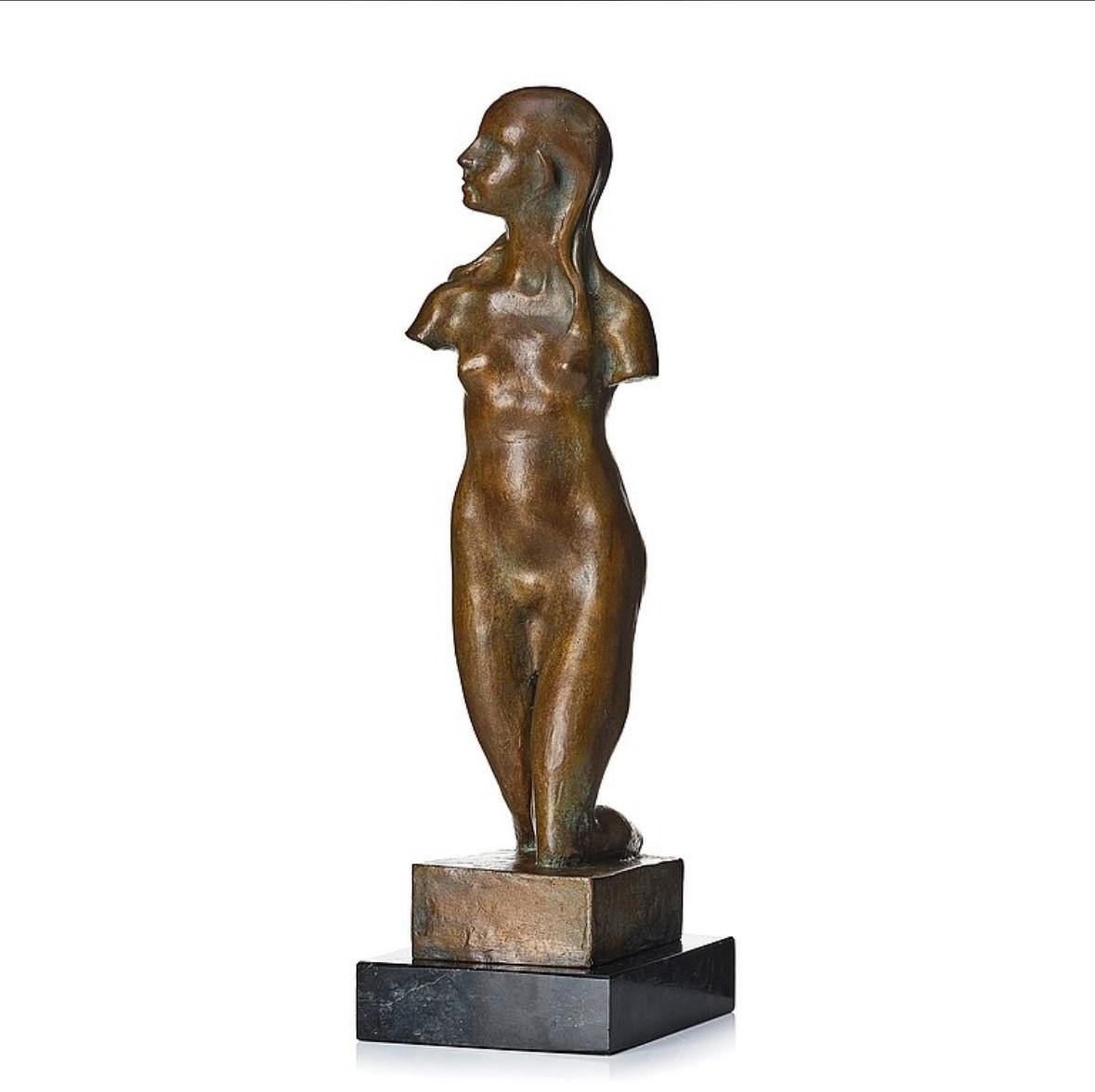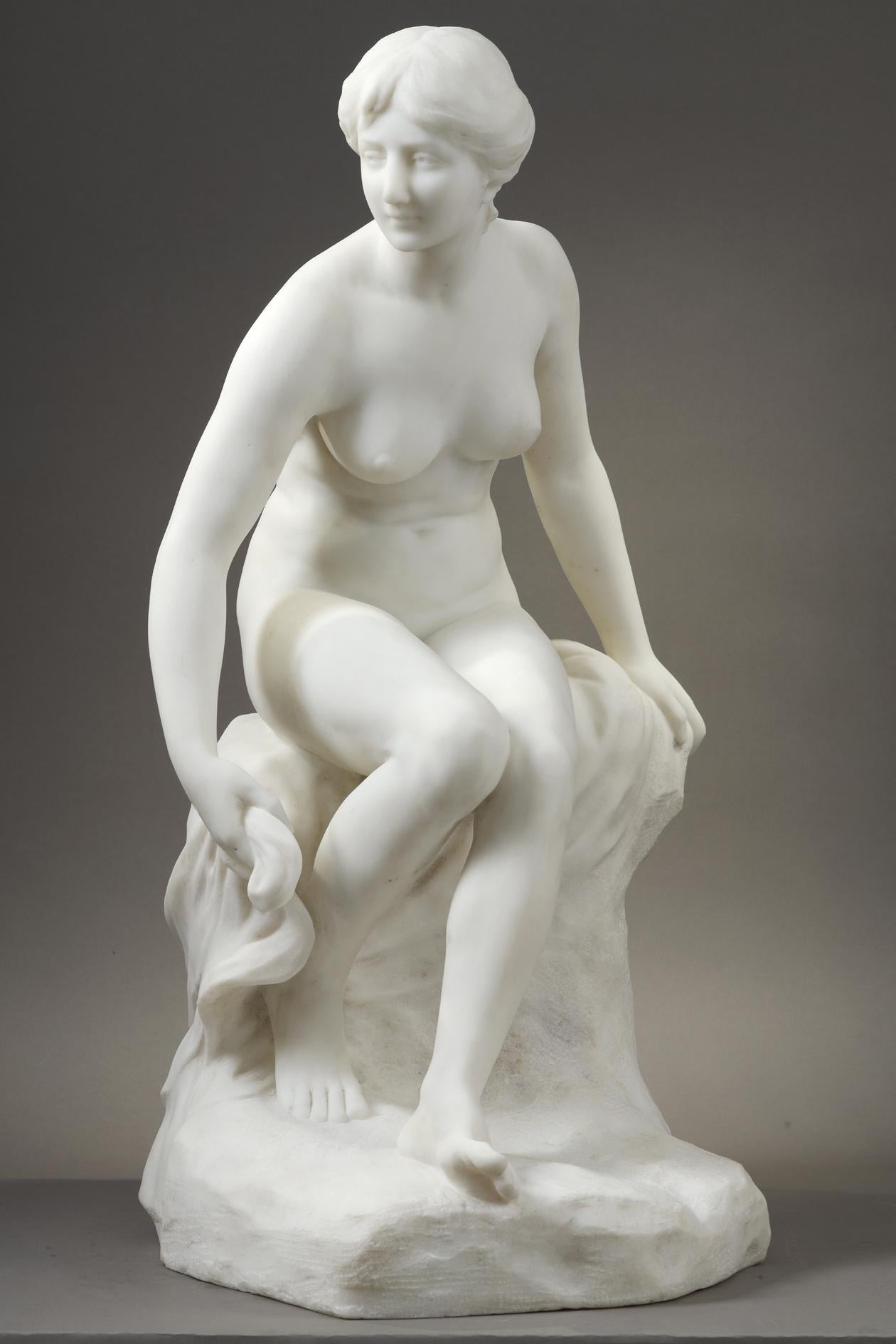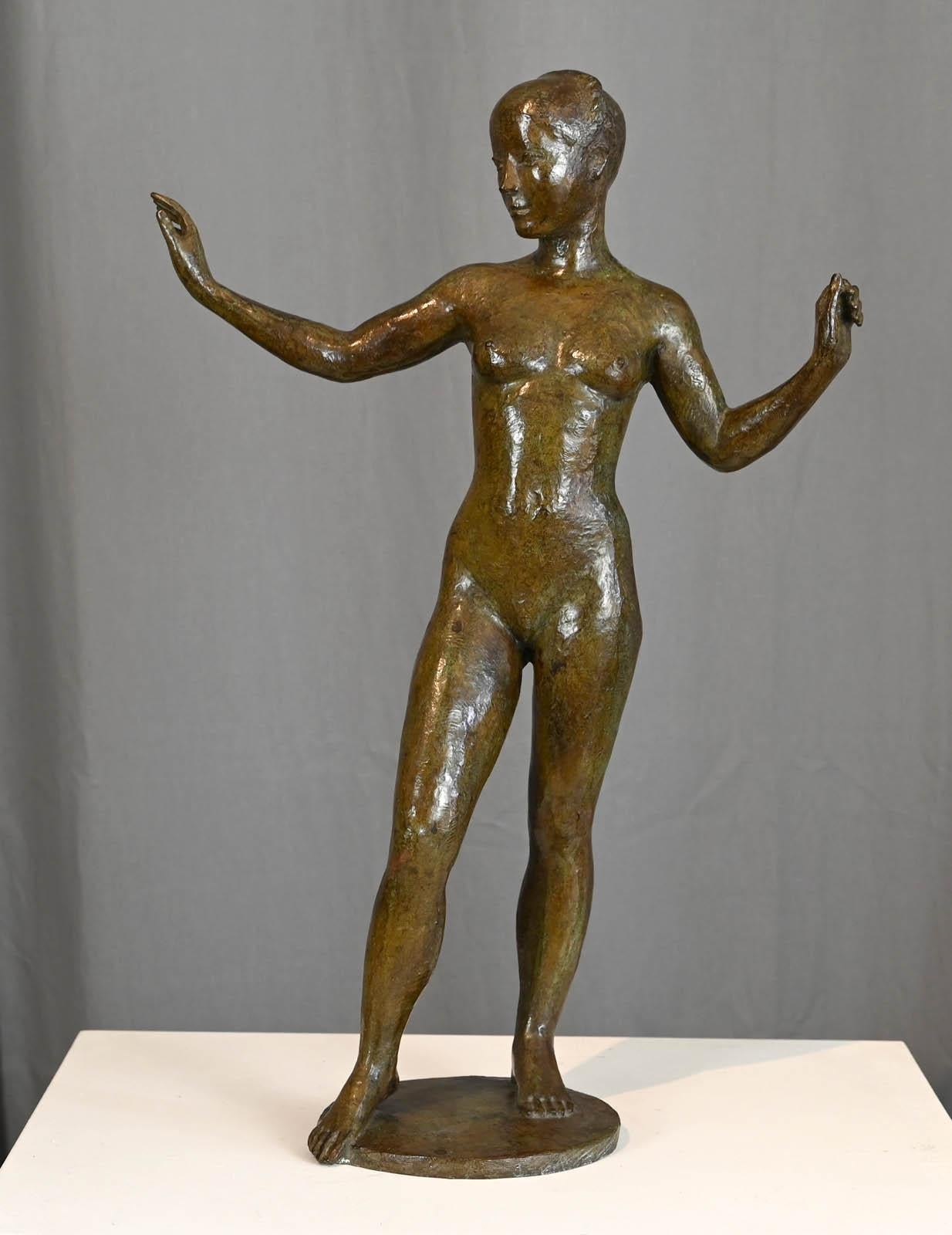Want more images or videos?
Request additional images or videos from the seller
1 of 16
Marcel GIMONDTorso of a Woman1927
1927
About the Item
Torso of a Woman
by Marcel GIMOND (1894-1961)
Avery fine nuanced brown chamotte sandstone sculpture
raised on a dark grey marble base
signed on the arm with the monogram "MG" for Marcel Gimond
inscribed with the monogram "GS" for Georges Serré
stamped by the galerie Rouard
France
1927
total height 50 cm
width 20,5 cm
depth 20 cm
After a model by Marcel Gimond, this bust was made in 1927 by Georges Serré at the Manufacture de Sèvres, sold exclusively by the Rouard Gallery, and exhibited the same year at the Paris Fall Fair (Salon d'Automne).
Reproduced in "Sculpteurs nouveaux, Marcel Gimond", Paul Fierens, Nrf, 1930, cover.
Biographies :
Marcel Gimond (1894-1961) was a French sculptor. He studied in Lyon, then at the School of Fine Arts in Lyon where he graduated in 1917. Finally he arrived in Paris the same year and settled in Marly-Le-Roi. Student of Aristide Maillol, he also met Raoul Dufy and Auguste Renoir. Gimond worked with Maillol until 1920, and left him to settle in Paris and regain his independence. He then moved into Renoir's former studio, made available by Jean Renoir. He exhibited at the Salon des Indépendants and the Salon d'Automne in 1922. In 1940, Gimond left Paris to settle in the South zone, in Lyon, then in Aix en Provence; He spent his summers at Saint-Félicien, at the house of poet Charles Forot.
At the Liberation, in 1944, he returned to Paris and his workshop rue Ordener, he left only a few months before his death. From 1946 to 1960, he directed a workshop at the Ecole des Beaux-Arts in Paris. Marcel Gimond was known for his busts of political and artistic personalities. He also owed two bas-reliefs located in the lobby of the newspaper "L'Humanité", in tribute to Marcel Cachin and Gabriel Péri.
Georges Serré (1889-1956) was a French ceramist. He worked at the Sèvres factory until 1914, when he was mobilized to go to war. He then went to Indochina where he taught ceramics at the art school of Bien-hoa for five years. On his return to France, he moved to Sèvres, rue Brongniart, but encountered difficulties in producing his works, until the intervention of the ceramist Emile Decoeur who obtained him help to build an oven for firing his ceramics. It was Georges Rouard and his gallery located on avenue de l'Opéra in Paris, who had noticed him at the International Exhibition of Modern Decorative and Industrial Arts of 1925, which presented him during his "exhibitions of contemporary French artisans".
Georges Serré's taste for these sandstones came to him, among other things, from Khmer sculptures, including a Buddha's head that he had brought back from Saigon, which had seduced him so much in Indochina. He liked the warm tone as much as the rough consistency pushing him to create a material that would be close to it. It was, at Rouard's request, that he produced reproductions of modern sculptures, including this bust by Marcel Gimond.
Georges Rouard (1874-1929), an erudite art lover, was in 1900 director of the auction house "A la Paix", founded twenty years earlier by Jules Mabut and located at 34 avenue de l'Opéra in Paris. Since 1914, he has promoted modern decorative arts, disseminated the works of decorative artists, glassmakers, goldsmiths and ceramists and founded the group of 'Contemporary French Craftsmen'. Each presents 15 to 20 pieces, twice a year for the Autumn and Spring exhibitions; in return, Rouard asked exhibitors to ‘consider him as the only merchant in Paris’.
The first exhibition entitled ‘Les Artisans Français Contemporains chez Géo Rouard’ took place in May 1914 with the participation of René Lalique, Clément Mère, Franz Waldraff, Georges Bastard, Jacques Lenoble, Emile Decoeur and Jean Dunand. The experience being conclusive, it was renewed every year until 1935 with also the ceramists René Buthaud, Auguste Delaherche, Pierre Lebasque, Jean Mayodon, Georges Serré, Henri Simmen, the glassmakers François Décorchemont, Henri Navarre, the coppersmiths Jean Dunand, Claudius Linossier, the goldsmiths Maurice Daurat, Jean Puiforcat, etc. An exclusive contract sometimes linked the gallery to members of 'Artisans Français Contemporains', which built loyalty among decorative artists, as they didn't exhibit their work in department stores.
In the 1920s, the renowned house "Galerie Rouard" presented table services from different manufacturers (manufacture royale de Saxe, Daum, Val Saint Lambert, Limoges, Boch Frères and of course Sèvres), crystals and artistic furniture from Gallé. Georges Rouard was himself president of the Chambre Syndicale de la Céramique et de la Verrerie, departmental inspector of technical education as well as a member of the board of directors of Union Centrale des Arts Décoratifs.
By presenting tableware and decorative arts in the same place of sale and by favoring unique pieces and semi-industrial editions, the Rouard gallery reached an audience of collectors and well-off enthusiasts.
After the sudden death of Georges Rouard in 1929, his son Paul took over the management of the house until 1931, then his son-in-law André Chesnay until 1966.
- Creator:Marcel GIMOND (1894 - 1961, French)
- Creation Year:1927
- Dimensions:Height: 19.69 in (50 cm)Width: 8.08 in (20.5 cm)Depth: 7.88 in (20 cm)
- Medium:
- Movement & Style:
- Period:
- Condition:Just to let you know, that the discolouration you see on legs is natural, due from the cooking of the piece.
- Gallery Location:PARIS, FR
- Reference Number:

About the Seller
5.0
Vetted Seller
These experienced sellers undergo a comprehensive evaluation by our team of in-house experts.
Established in 1992
1stDibs seller since 2023
Typical response time: 1 to 2 days
- ShippingRetrieving quote...Ships From: PARIS, France
- Return PolicyA return for this item may be initiated within 3 days of delivery.
More From This SellerView All
- BatherLocated in PARIS, FRBather by Etienne Hachenburger (19th-20th C.) Sculpture in white Carrara marble Signed on the side of the base "E. Hachenburger" A simiilar model was exhibited at the Paris Salon oh...Category
Early 1900s French School Nude Sculptures
MaterialsMarble
- Snake CharmerBy Albert-Ernest Carrier-BelleuseLocated in PARIS, FRBronze sculpture with a nuanced dark brown patina signed on the base "A. Carrier" inscribed on a front plaque "Charmeuse de Serpents par Carrier-Belleuse" France circa 1860 height 80,5 cm Biography : Albert-Ernest Carrier de Belleuse known as Carrier-Belleuse (1824-1887) was one of the most prolific artists of the century and had the greatest successes under the Second Empire, enjoying the personal support of Napoleon III. His work was greatly influenced by the style of the Italian Renaissance and that of the 18th century, which he helped to bring up to date. In 1837, the young Carrier-Belleuse apprenticed in the workshop of the engraver Bauchery. He was admitted soon after to the goldsmith Jacques Henri Fauconnier. Through François Arago, he met the sculptor David d'Angers who facilitated his admission to the School of Fine Arts. Carrier-Belleuse entered it in 1840. Noted for his skill by the great bronze companies in Paris such as Barbedienne and Denière, he soon received numerous orders for models for candelabras, pendulums, fittings for fireplaces, etc. In 1848, probably at the initiative of François Arago, who became head of state, he received his first public order for a small statue of "Mademoiselle Rachel singing La Marseillaise". In 1851, he appeared for the first time at the Salon of French Artists, where he presented two bronze medallions. From 1851 to 1855, Carrier-Belleuse stayed in England, in Stoke-on-Trent where he served as director of the modeling and drawing school of the Minton house, a large porcelain manufacturer. Back in France, Carrier-Belleuse moved to Paris in a large workshop located 15 rue de la Tour d´Auvergne. From 1857, he made regular sendings to the Salon and became famous thanks to the success of large marbles, such as the "Bacchante" exhibited at the Salon in 1863, and acquired by Napoleon III, "Angelica" (1866) or even "Hebe asleep" (1869). At the Salon of 1867, his group entitled "Messiah" earned him the medal of honor of sculpture. It was acquired by the State to adorn the Chapel of the Virgin in the Saint-Vincent-de-Paul church. Carrier-Belleuse acquired a great reputation in parallel for his terracotta busts which, in many respects, recall those of 18th century artists. He made portraits of a large number of celebrities of his time. He produced, among others, the busts of Napoleon III, Renan, Thiers, Grévy, Arago, Marguerite Bellanger, Théophile Gautier, Honoré Daumier, Delacroix, Hortense Schneider, Réjane… He also modelled numerous busts of mythological inspiration and historical and artistic portraits like Marie Stuart, Shakespeare or even Mozart. Carrier-Belleuse used and trained in his workshop in the rue de la Tour d´Auvergne many young talented artists such as Alexandre Falguière, Jules Desbois...Category
1860s French School Figurative Sculptures
MaterialsBronze
- The ComedyLocated in PARIS, FRPierre-Marie POISSON (1876-1953) The Comedy Bronze sculpture with black patina signed on the base "P. Poisson" Cast by Valsuani (with the foundry stamp) Raised on a stone base Fra...Category
1930s French School Figurative Sculptures
MaterialsBronze
- Woman taking off her shirtLocated in PARIS, FRWoman taking off her shirt by James PRADIER (1790-1852) Bronze with a nuanced brown patina cast by SOYER and INGE France circa 1850 height 28,5 cm Biography : Jean-Jacques Pradier...Category
1850s French School Nude Sculptures
MaterialsBronze
- The KissBy Aimé-Jules DalouLocated in PARIS, FRThe Kiss also named "Nymph and Faun" by Jules DALOU (1838-1902) A bronze group with a black patina Signé "Dalou" A very fine cast by "A.A. Hébrard" (with the foundry stamp) The ca...Category
Early 1900s French School Figurative Sculptures
MaterialsBronze
- Diana with an arrowBy Albert-Ernest Carrier-BelleuseLocated in PARIS, FRDiana with an arrow by Albert-Ernest CARRIER-BELLEUSE (1824-1887) Bronze sculpture with a dual light and dark brown patina signed on the base "Carrier-Belleuse" inscribed on a front plaque "Diane à la Flèche par Carrier-Belleuse (Sculptr)" France circa 1870 height 83 cm arrow added probably in the 20th c. Biography : Albert-Ernest Carrier de Belleuse known as Carrier-Belleuse (1824-1887) was one of the most prolific artists of the century and had the greatest successes under the Second Empire, enjoying the personal support of Napoleon III. His work was greatly influenced by the style of the Italian Renaissance and that of the 18th century, which he helped to bring up to date. In 1837, the young Carrier-Belleuse apprenticed in the workshop of the engraver Bauchery. He was admitted soon after to the goldsmith Jacques Henri Fauconnier. Through François Arago, he met the sculptor David d'Angers who facilitated his admission to the School of Fine Arts. Carrier-Belleuse entered it in 1840. Noted for his skill by the great bronze companies in Paris such as Barbedienne and Denière, he soon received numerous orders for models for candelabras, pendulums, fittings for fireplaces, etc. In 1848, probably at the initiative of François Arago, who became head of state, he received his first public order for a small statue of "Mademoiselle Rachel singing La Marseillaise". In 1851, he appeared for the first time at the Salon of French Artists, where he presented two bronze medallions. From 1851 to 1855, Carrier-Belleuse stayed in England, in Stoke-on-Trent where he served as director of the modeling and drawing school of the Minton house, a large porcelain manufacturer. Back in France, Carrier-Belleuse moved to Paris in a large workshop located 15 rue de la Tour d´Auvergne. From 1857, he made regular sendings to the Salon and became famous thanks to the success of large marbles, such as the "Bacchante" exhibited at the Salon in 1863, and acquired by Napoleon III, "Angelica" (1866) or even "Hebe asleep" (1869). At the Salon of 1867, his group entitled "Messiah" earned him the medal of honor of sculpture. It was acquired by the State to adorn the Chapel of the Virgin in the Saint-Vincent-de-Paul church. Carrier-Belleuse acquired a great reputation in parallel for his terracotta busts which, in many respects, recall those of 18th century artists. He made portraits of a large number of celebrities of his time. He produced, among others, the busts of Napoleon III, Renan, Thiers, Grévy, Arago, Marguerite Bellanger, Théophile Gautier, Honoré Daumier, Delacroix, Hortense Schneider, Réjane… He also modelled numerous busts of mythological inspiration and historical and artistic portraits like Marie Stuart, Shakespeare or even Mozart. Carrier-Belleuse used and trained in his workshop in the rue de la Tour d´Auvergne many young talented artists such as Alexandre Falguière, Jules Desbois...Category
1870s French School Nude Sculptures
MaterialsBronze
You May Also Like
- Female torsoLocated in Täby, SEGunnar Knut Nilsson, born 1904 in Karlskrona, died 1995 in Versailles in France, was a Swedish sculptor. Gunnar Nilsson studied watercolor painting and modeling at the Technical Vocational School in Karlskrona in 1918-19 and on his own in addition to working as a clerk at Finspångs Metallwerk. His debut exhibition was in Finspång in 1927. With the help of a local fundraiser, and after the encouragement of Carl Eldh, he traveled to Paris in 1928 to study sculpture for, among others, Charles Despiau and Paul Niclausse. In Paris he socialized with Bror Hjorth, whose former studio he also rented, Carl Frisendahl and Alberto Giacometti. He came to belong to "Le groupe des Neuf'' with Paul Cornet...Category
1950s French School Nude Sculptures
MaterialsBronze
- MarieLocated in LE HAVRE, FRJacques COQUILLAY (né en 1935) Marie Original bronze Size : 56x39x17cm Copy No. 4/8 Signature and numbered on the base. Original bronze made with ...Category
Early 2000s French School Nude Sculptures
MaterialsBronze
- VictoireLocated in LE HAVRE, FRJacques COQUILLAY (né en 1935) Victoire Original bronze Size : 105 x 22 x 20 cm Copy No. 1/8 Signature and numbered on the base. Original bronze m...Category
Early 2000s French School Nude Sculptures
MaterialsBronze
- Medusa and AndromedaBy Magdeburger Kunstwerkstatten Reps and TrinteLocated in West Hollywood, CAMedusa and Andromeda, is a unique three dimensional terra cotta sculpture/vase, created by the German firm Magdeburger Kunstwerkstatten, Reps and Trinte, a studio that specialized in fine works in terra cotta. This monumental piece depicts the entire story of the Medusa, who holds Andromeda captive by chaining her to rocks in the ocean. You can see the chains at her wrists and ankles. Medusa charges the Leviathan (dragon) as guard over the captive Andromeda. Andromeda was rescued by her future husband Perseus who killed the dragon and saved his future bride. This is one of the most unique works of its kind that has been seen to date. It was probably a sculpture/vase designed and created for presentation at one of the yearly Salon exhibitions in Europe. We have consulted experts in European ceramics...Category
Early 1900s Figurative Sculptures
MaterialsTerracotta
- Sculpture Terracotta Female Nude From Marcel Bouraine (1886-1948)By Marcel-André BouraineLocated in Saint-Ouen, FRSculpture Terracotta From Marcel Bouraine (1886-1948)" Original terra cotta sculpture of Marcel Bouraine Naïade of the 1930's Signed Bouraine On the ...Category
1930s Academic Nude Sculptures
MaterialsTerracotta
- Unveiling - Sculpture by Maryam Pezeshki - 2021Located in Roma, ITUnveiling is a contemporary artwork realized by Maryam Pezeshki in 2021 Terracotta sculpture. Original title: Svelamento Maryam Pezeshki was born in Tehran on August 18, 1977. SHe began to paint at the age of three. Her first painting was a Pinocchio. Participate in national and international painting competitions and festivals among Asian and Iranian children, winning first prize each time. At the age of ten she participated in a television program entitled "Little Great Artists". At the age of fourteen she won the prize for the best drawing and sculpture among Iranian teenagers, and she enrolled in the artistic high school, continuing to do her first personal exhibitions of sculpture, painting and drawing. From the age of seventeen to nineteen she won the national prize for best sculpture at the youth festival for three consecutive years. At seventeen he enrolled at the University of Art in the graphics sector and at twenty-one he graduated with full marks. In the same year she began studying for the master of graphics and managed to be among the seven students admitted. At the age of twenty-five she finished his studies and won a competition for teaching drawing and sculpture at the University of Art. In the meantime, visit the European and Indian museums...Category
2010s Contemporary Figurative Sculptures
MaterialsTerracotta
Recently Viewed
View AllMore Ways To Browse
Request A Return
Antique Fair Paris
Antique Avenue
Sculpture Of French Woman
Sculpture Of A Buddha
Antique 20furniture
Merchants Of France
Marcel T
Woman Head Sculpture
Head Of A Woman Sculpture
Lobby Sculptures
Saint George Sculpture
George Bust
Torso Model
French Marble Sculpture Woman
After Daum
Terracotta Group
Terracotta Woman


